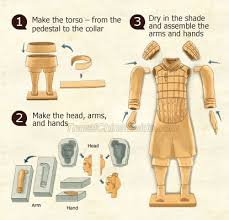
Why Was the Terracotta Army Created?
A Glimpse into the Afterlife Beliefs of Ancient China
The Terracotta Army, a vast collection of life-sized terracotta figures, stands as a testament to the grandeur and ambition of Qin Shi Huang, the first emperor of China. To understand the purpose behind this monumental creation, we must delve into the ancient Chinese beliefs surrounding life and death.
The ancient Chinese perceived the cosmos as a duality of Yin and Yang, representing the complementary forces of shadow and light, female and male, and death and life. This concept extended to their understanding of the afterlife, which was not seen as an end but as a continuation of earthly existence in a parallel realm.
Central to this belief was the principle of "viewing death as life" (视死如生). It was believed that individuals continued to exist in the afterlife much as they did in the mortal world, retaining their social status, desires, and needs. Therefore, just as a powerful ruler needed a formidable army in life, so too would he require one in the afterlife to maintain his authority and protect his dominion.
An Army for Eternity
Driven by this conviction, Qin Shi Huang, known for his ambition and desire for immortality, commissioned the creation of the Terracotta Army. This vast legion of terracotta warriors, chariots, and horses was not merely symbolic; it was intended as a tangible manifestation of military might meant to serve the emperor in his afterlife.
Each figure, meticulously crafted with unique facial features, hairstyles, and attire, reflects the meticulous attention to detail that characterized Qin Shi Huang's reign. The variety in their appearances suggests that they were modeled after actual soldiers and officers who served in the Qin army. From the stern expressions of the generals to the unwavering gazes of the foot soldiers, the Terracotta Army embodies the discipline, strength, and unwavering loyalty that defined Qin Shi Huang's reign.
A Testament to Qin Military Prowess
The Terracotta Army serves not only as a window into ancient Chinese beliefs about the afterlife but also as a testament to the military prowess of the Qin Dynasty. The sheer scale of the project, the advanced craftsmanship involved, and the meticulous attention to detail in each figure speak volumes about the resources, organization, and skill possessed by the Qin empire.
The presence of various military divisions within the Terracotta Army, including infantry, cavalry, and charioteers, provides valuable insights into the military structure and strategies employed by the Qin army. The weapons buried with the soldiers, though largely looted over the centuries, were state-of-the-art for their time, showcasing the advanced military technology of the Qin Dynasty.
Q&A
Q: What is the significance of the different facial expressions and attire of the Terracotta Army figures?
A: The variations in facial features, hairstyles, and clothing suggest that the figures were modeled after actual soldiers in the Qin army, possibly even heroes or individuals of particular rank. This detail highlights the emperor's desire for a personalized and realistic afterlife army.
Q: Why were the Terracotta Warriors buried alongside the emperor?
A: Qin Shi Huang, driven by his belief in the afterlife and the principle of "viewing death as life," had the Terracotta Army interred with him to provide protection and maintain his authority in the afterlife.
Q: Besides their religious significance, what do the Terracotta Warriors tell us about the Qin Dynasty?
A: The Terracotta Army provides invaluable insights into the military organization, weaponry, and craftsmanship of the Qin Dynasty, showcasing their advanced technological capabilities and the impressive scale of their resources and manpower.